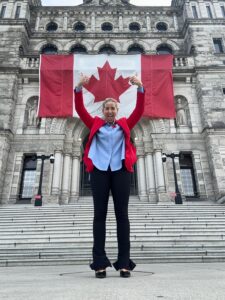Expect some soon, says the health minister, nearly two years after NDP election pledge.
Andrew MacLeod 14 Mar 2022

[Excerpt] A few months before the 2020 British Columbia election, the government made an “historic” announcement of 495 new long-term care beds to be created in the province’s interior region.
The promise was welcome news covered widely in the local media, but nearly two years later major questions about the beds and how they will be managed remain unanswered.
Ann Godderis, who lives in Castlegar and works in Trail, watched the announcement and what happened afterwards carefully. “It was an interest and a concern and then it just died,” she said. “We couldn’t find out anything.”
More long-term care beds are badly needed in the region, she said, but it matters a great deal whether they are really new and not just replacements for ones in older facilities that may close.
It’s also important that the beds be kept in the public sector, Godderis said.
“These beds are paid for by our money,” she said, noting the funding comes both from residents of the homes and the government. “I’m just strongly opposed to putting any money into the hands of shareholders. Private for-profit doesn’t belong in health care. I just think it’s wrong.”
The pre-election promise the government made was for 140 beds in Kelowna, 100 in Kamloops, 90 in Vernon, 90 in Penticton and 75 in Nelson.
The beds would increase the number available in the interior by 10 per cent, it said, bringing the total to 6,550.
“The plan we are setting in motion today for nearly 500 beds is what people in the region need,” Health Minister Adrian Dix said at the time. “This historical investment is a commitment to seniors living in Interior communities, an assurance that care close to home will be available, when they need it.”
Exact locations were to be determined following a bidding process. Interior Health issued five requests for proposals and the results were to be evaluated in the fall of 2020. Contracts were to be awarded in early 2021.
Meanwhile the B.C. General Employees’ Union or BCGEU campaigned against the government’s plan to contract out 85 per cent of the new beds.
“There’s no guarantee that the contracts won’t go to for-profit nursing home chains that make millions in profits by cutting corners, neglecting seniors and mistreating workers,” the union said on a page encouraging people to write to Dix and the finance minister.
“These privately-owned corporate chains have armies of lobbyists that are probably already planning ways to secure those contracts,” it said. Unless there’s a massive public outcry, they might succeed…. We can drown out the lobbyists, and stop the government from handing over more seniors’ care to big corporations.”
Asked last week [March 9] for an update on the procurement process, Interior Health said, “The RFPs issued on July 13, 2020 have closed. We are currently working with the successful proponents and will have more information to share soon.”
Results on the government’s B.C. Bid website show the competitions all closed in October 2020.
‘At least some’ beds to be announced: Dix
Health Minister Dix said some of the results will be released shortly. “I think you’re going to see an announcement about at least some of those beds in the next two weeks,” he said.
Some, particularly those planned for Nelson, will be public, Dix said. “Others will be similar to beds developed over time,” he said. “In other words they’ll be contract beds, they’ll be public beds in private for-profit and not-for-profit care homes.”
The government’s focus is on continuing to refurbish homes built decades ago, increase the number of available beds as the population of seniors grows, reduce the number of shared rooms, improve infection control and raise staffing standards, he said.
The president of the BCGEU, Stephanie Smith, said the union’s campaign about the new beds for the interior resulted in almost 2,000 letters written to the government.
“We want to see an end to private for-profit seniors’ care,” Smith said in an email. “We hope to hear from government soon on this RFP and on the larger goal of getting the profit motive out of seniors’ care.”
The government has taken important steps by bringing home care and contracted hospital services back into the public system, she said.
Smith noted that the BC NDP’s 2020 election platform said, “BC Liberals doled out hundreds of millions to for-profit corporations to create new care homes — and it failed miserably.”
The party’s platform also mentioned four private care homes that were put under public administration for failing to provide the required levels of care, highlighted that for-profit care home operators had failed to deliver more than 200,000 hours of care the public paid them to provide, and that there was a need for “building better, public long-term care homes.”
“We’re hoping to see government follow through on their commitments and award these new contracts to not-for-profit operators,” Smith said.
“The involvement of for-profit corporations in long-term care is a huge concern,” she added. “These companies pad their profit margins by underpaying workers and cutting corners on care — and seniors and workers suffer the consequences.”
The COVID-19 pandemic exposed the dangers of a profit-driven seniors’ care system, Smith said. “Data from Ontario, where most long-term care is for-profit, show that residents were four times more likely to die during COVID-19 outbreaks in for-profit facilities than in public facilities.”
The for-profit care model is dangerous for both seniors and workers and needs to end, she said.
Read more at: Where Are the 495 Long-Term Care Beds Promised for BC’s Interior?





